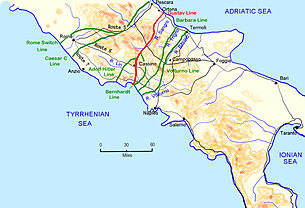Barbara line
Barbara Line was the code name for one of the slightly expanded German defense lines in central Italy during World War II . It was about 10-20 km south of the Gustav Line from Colli a Volturno to the Adriatic coast in San Salvo and at a similar distance north of the Volturno Line. Near the eastern coast, the line of defense ran along the Trigno River. The line mainly consisted of fortified hill positions.
Western breakthrough by the 5th US Army
Field Marshal Albert Kesselring , German Commander in Chief in Italy, relocated his troops back to the Barbara Line on October 12, 1943, after the American 5th US Army had crossed the Volturno River and breached the Volturno Defense Line . At the beginning of November, the Barbara Line on the Tyrrhenian Sea side of the Apennine Mountains was broken by the 5th US Army and the German forces withdrew to the Bernhardt Line or to the Gustav Line.
Eastern breakthrough by the British 8th Army
The Allied armies in Italy under the command of General Sir Harold Alexander fought northward against the determined German opponents led by Albert Kesselring, who had prepared a number of lines of defense. On the Adriatic front east of the Apennine mountain range, the British 8th Army under General Bernard Montgomery was in command. In October the 8th Army had crossed the river Bifurno and on October 6th broke through the Viktor / Volturno line. However, they had to pause in front of the Trigno River to reorganize their supplies along the bad roads to Bari and Taranto 190 km and 270 km away respectively. Delayed by these logistical problems, the Allies could not immediately attack the next line of defense, the Barbara line behind the Trigno. It was not until a month later, in the early morning hours of November 2nd, that the V Corps attacked the coast on the right side and the XIII. Corps on their left side the German positions on the River Trigno. In addition to V Corps, the British 78th Infantry Division attacked along the coastal road, while the 8th Indian Infantry Division attacked 16 km inland. The fighting was fierce, but on November 3rd the British 78th Division reached the town of San Salvo , some 5 km across the river, in the place of which Major General Rudolf Sieckenius, commander of the 16th Panzer Division, withdrew behind the Sangro River . There the Gustav Line was expanded with a view of the river from the hilltops on the other side. The Allied advance reached the Sangro on November 9th without much resistance.
See also
literature
- Field Marshal Lord Carver: The Imperial War Museum Book of the War in Italy 1943–1945 . Sidgwick & Jackson, London 2001, ISBN 0-330-48230-0 .
- David Hume: From the Volturno to the Winter Line 6 October – 15 November 1943 . Ed .: Fifth Army Historical Section - United States Army Center of Military History (= CMH Pub . Volume 100-8 ). CMH Online, Washington 1990, ISBN 0-16-001999-0 ( archive.org - first edition: 1945).
- Col. Kenneth V. Smith: Naples-Foggia. 9 September 1943–21 January 1944 . Ed .: United States Army Center of Military History (= CMH Pub . Volume 72-17 ). CMH Online, Washington, DC 1990, OCLC 835824598 ( webdoc.sub.gwdg.de ).
Individual evidence
- ^ Field Marshal Lord Carver: The Imperial War Museum Book of the War in Italy 1943-1945 . Sidgwick & Jackson, London 2001, ISBN 0-330-48230-0 , pp. 90 .


